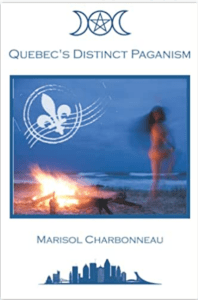Robert Mathiesen and Theitic, The Rede of the Wiccae: Adriana Porter, Gwen Thompson and the Birth of a Tradition of Witchcraft (Providence, R.I.: Olympic Press, 2005), 167 pp., $17.95 (paper).
• • •
Gwen Thompson (Craft name of Phyllis Healy), 1928–1986, founded the New England Coven of Traditional Witches in the late 1960s. It went on to have various offshoots.
Central to her position as founder of the NECTW tradition was a “grandmother story.” She claimed to have been taught “the Old Religion” (in Margaret Murray’s sense) by her grandmother, Adriana Porter (1857–1946), an underground Craft teaching that supposedly originated in the West of England, in Somerset. Porter was born in Nova Scotia, married William Healy, a bookkeeper and insurance broker, in 1888, and moved with him first to Rhode Island and then to Melrose, Mass. They had one son, Walter, Gwen’s mother’s first husband.
According to Gwen Thompson, her grandmother’s family “were carriers of a secret tradition of Folk Witchcraft,” although her mother had broken with it upon marrying her second husband. Nevertheless, by then Adriana had initiated her and given her the Craft name of Gwen. When Adriana died, Gwen found some of her papers, which she considered to be a Book of Shadows, and which she copied. But she always “refused to tell her initiates anything about the identity of her living relatives, saying, ‘They don’t want to talk to you!'”
This study of her claims has two authors. One, Robert Mathiesen, never met her. Now retired from the Dept. of Slavic Languages at Brown University, he has “a life-long interest in the history of magical practices and doctrines and alternative religions” Theitic, on the other hand, was Thompson’s student from 1974–78 and is now considered to be the historian of the NECTW tradition.
Mathiesen faced one daunting obstacle — he was not allowed to look at Gwen’s Book, except for a part, the Rede (Old English for “counsel”) that had been published in the Pagan magazine Green Egg in 1975. Most of the Rede is traditional folk wisdom, such “With the fool no season spend / or be counted as his friend.” Other couplets contain wisdom more appropriate to seamen in the days of sail rather than farmers, which could connect them with a port such as Yarmouth, Nova Scotia.
The collection as published starts and finished with other couplets that sound a great deal like Gerald Gardner or Doreen Valiente. As Mathiesen writes, they “use the false archaism Wiccan and strongly echo Gardner’s form of Wicca.”
Mathisen researched Adriana Porter’s family history extensively, and he notes that when she came to the Boston are in the 1880s, she had the leisure and income to have investigated Spiritualism, Rosicrucianism, Theosophy, and other esoteric currents in that city. Since this book’s publication, he has found hints that she might have known Paul Foster Case, in the 1920s. Case was a ceremonial magician and founder of the mystery school Builders of the Adytum, which still exists.
But the so-called Old Religion? The authors conclude that between 19 and 21 of the 26 couplets in the Rede might well have been written down by Adriana Porter, or else some other 19th-century person. The rest, those that give it a Wiccan flavor, were added almost certainly by Gwen Thompson.
It is another example of what I call “the Gardnerian magnet.” Because books by Gardner and his associates became available from 1957 on, many people not part of that initiatory lineage “borrowed” from it heavily.
Adriana had opportunities to become well acquainted with various occult and esoteric teachings. But there is nothing to prove that she carried forward a deep ancestral tradition of Witchcraft as an alternative religion.
My own larger conclusion is that I still have seen no credible evidence for anyone practicing a self-consciously polytheistic Pagan religion called Wicca or Witchcraft prior to 1951 in the English-speaking world.* What we find, instead, are cases such as these:
- A Craft leader drops bits of information about their own or an ancestor’s involvement in an esoteric school, ceremonial magical group, etc. and passes that off as an ancestral tradition. Such may well have been the case with Gwen Thompson.
- A person’s ancestor knew herbalism, root-working, card-reading or other divination, spell-casting, water-witching, conjuring, astrology, etc. — even in a Christian context — and their descendent describes this involvement as an ancestral tradition of Witchcraft in order to legitimize their own position in the new religion of Pagan Witchcraft.
Research projects such as The Rede of the Wiccae are needed, therefore, to settle some of these historical questions — inasmuch as they can be settled — and free scholarship on contemporary Paganism to view it through other lenses.
* Yes, I include Philip Heselton’s work here, as detailed in this book review.
Like this:
Like Loading...

 From the New York Times (but this link gets you past the paywall)
From the New York Times (but this link gets you past the paywall)  As ever, book reviews in The Pomegranate: The International Journal of Pagan Studies are open-access free downloads. Here are links to the four in this issue.((I receive a small commission on Amazon sales, which helps to pay for this website.))
As ever, book reviews in The Pomegranate: The International Journal of Pagan Studies are open-access free downloads. Here are links to the four in this issue.((I receive a small commission on Amazon sales, which helps to pay for this website.))

 The Imagination of Plants: A Book of Botanical Mythology
The Imagination of Plants: A Book of Botanical Mythology




